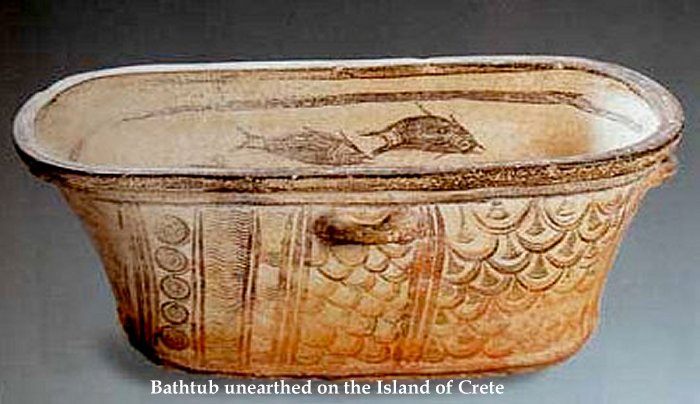Was Hygiene Important For Our Ancestors?
A. Sutherland - AncientPages.com - How important was hygiene in ancient times and expectations about keeping oneself clean?
Although the term "hygiene" came into use at the beginning of the nineteenth century, an instinctive desire to preserve or restore purity is very old.
Written sources, iconography and a variety of artifacts demonstrated a significant role of hygiene and each epoch had its ‘own way’ of understanding of dirt and cleanliness.
Ancient societies put a great deal of importance on bathing. In ancient times, it was generally believed that hygiene was the most effective means to fight disease. Antiquity was the cleanest epoch in human history.
The ancient Egyptians, for example, rightly assumed that high temperatures and considerable humidity of the Nile River could result in the development of diseases.
According to the Ebers Papyrus, a medical document dated to about 1500 BC, the ancient Egyptians bathed regularly and mixed vegetable and animal oils with alkaline salts were used to form a soap-like material. These ancient people daily used a lot of makeup cosmetics such as cream, pastes and face masks. Daily bathing helped to remove both makeup and other impurities. Cleanliness was also dictated by religious considerations.
The designs of entire cities in the Harappan culture included centralized baths and running water and in the Indus valley, archaeologists have discovered the first toilet 4,500 years.
The Hindus tradition of bathing and its benefits was known 3,000 years ago.
The Ancient Greeks adopted the idea of bathing from the Hindus, who were familiar with the benefits of bathing as early as 3,000 years ago. Baths were initially not so much a way of daily care of the body, but rather a kind of ritual.

Ancient tapestry depicting a heavily romanticized courtly bath in the early 1500s, set in a woodland glade, surrounded by various delights such as food, music, sweet smells. Image credits: Cluny Museum
Greek homes, even those not wealthy ones, were equipped in ceramic tiled baths. Baths - connected with a variety of beauty treatments and numerous utensils for bathing purposes - purified and strengthened the body.
Archaeological findings confirm that the first known to us, bathtub comes from the palace of Knossos on Crete - 1700 BC an the earliest known flushing toilet, which was screened off by partitions and was flushed by water kept in cisterns or by rain water.
The Romans had large public baths and incredibly popular thermal baths. The Finns popularized the sauna, which was also used by the Koreans (“hanjeungso”), the Karo people of Indonesia (oukop), and the so-called “Turkish Bath” was used throughout the Middle East.
Medieval Europeans bathed less frequently than their Norse forerunners, who bathed at least once a week. However, to say that medieval faces, hands, and bodies were always dirty, their clothes were evil-smelling and everything around them was dirty, would be to condemn all medieval people. It would be unfair to do so.
If you had the money, you could pay for servants to heat water and fill a wooden tub for one,
but most people used the public baths. Based on ancient sources, by the thirteenth-century there were thirty-two bathhouses in Paris and eighteen in London; even the smaller towns had bathhouses.
The Medieval Europeans have always valued a nice smelling plant, but oils, soap, colognes and perfume. The art of perfume and other wonderful smells such as rosewater originated from the Holy Lands and was brought to Europe by the crusaders.
Maino De Maineri (also known as Magninus Mediolanensis, who died in 1368, was a 14th-century Italian physician, astrologer and writer, described more 57 bathing prescriptions and gave his own rules to use in specific conditions, such as traveling, pregnancy and old age.
Before the Middle Ages, public baths were much more common and still, during the 4th and 5th centuries, Christian authorities allowed people to bathe for cleanliness and health. However, the Church condemned attendance to public bath houses for pleasure and condemned women going to bath houses that had mixed facilities.
Over time, more and more restrictions appeared for Christians, who were prohibited from bathing naked. Eventually, public bathing was considered immoral activity that led to diseases and prostitution.
Written by – A. Sutherland AncientPages.com Staff Writer
Copyright © AncientPages.com All rights reserved. This material may not be published, broadcast, rewritten or redistributed in whole or part without the express written permission of AncientPages.com
Expand for referencesReferences:
T. Scully, The Art of Cookery in the Middle Ages
S. Cavallo,T. Storey, Healthy Living in Late Renaissance Italy
More From Ancient Pages
-
 Rare And Well-Preserved Inka Tunic Discovered In Chile
Archaeology | Feb 14, 2023
Rare And Well-Preserved Inka Tunic Discovered In Chile
Archaeology | Feb 14, 2023 -
 Giant Balor Of The Evil Eye – Terrifying Fomorian King And Grandfather Of Celtic God Lugh
Celtic Mythology | Apr 30, 2018
Giant Balor Of The Evil Eye – Terrifying Fomorian King And Grandfather Of Celtic God Lugh
Celtic Mythology | Apr 30, 2018 -
 Remarkable Thracian Tomb In Huge Mound Necropolis Of Kazanlak, Bulgaria
Featured Stories | May 13, 2024
Remarkable Thracian Tomb In Huge Mound Necropolis Of Kazanlak, Bulgaria
Featured Stories | May 13, 2024 -
 Ancient Copy Of Jesus’ Secret Teachings To His Brother James Discovered – First Apocalypse And Future Events Described
Artifacts | Dec 2, 2017
Ancient Copy Of Jesus’ Secret Teachings To His Brother James Discovered – First Apocalypse And Future Events Described
Artifacts | Dec 2, 2017 -
 Ukraine – A Place Where People From Different Cultures Intersected Until About 500 Years Ago
Archaeology | Jan 14, 2025
Ukraine – A Place Where People From Different Cultures Intersected Until About 500 Years Ago
Archaeology | Jan 14, 2025 -
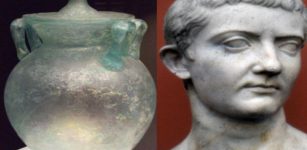 Flexible Glass – Lost Ancient Roman Invention Because Glassmaker Was Beheaded By Emperor Tiberius
Ancient Technology | Jul 27, 2023
Flexible Glass – Lost Ancient Roman Invention Because Glassmaker Was Beheaded By Emperor Tiberius
Ancient Technology | Jul 27, 2023 -
 Australia’s Two-Meter-Long And Oldest Known Rock Painting Of A Kangaroo – Revealed
News | Feb 23, 2021
Australia’s Two-Meter-Long And Oldest Known Rock Painting Of A Kangaroo – Revealed
News | Feb 23, 2021 -
 How Did 20th-Century Philosophers Explain Ghosts And Other Spooky Subjects?
Featured Stories | Nov 8, 2024
How Did 20th-Century Philosophers Explain Ghosts And Other Spooky Subjects?
Featured Stories | Nov 8, 2024 -
 Zapotecs’ Magnificent City Of Mitla Was Destroyed By A Seismic Landslide
Archaeology | Aug 23, 2024
Zapotecs’ Magnificent City Of Mitla Was Destroyed By A Seismic Landslide
Archaeology | Aug 23, 2024 -
 Secrets Of Ancient Ivory Manikins Revealed
Archaeology | Nov 28, 2019
Secrets Of Ancient Ivory Manikins Revealed
Archaeology | Nov 28, 2019 -
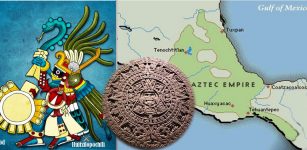 Why The Aztecs Called Themselves ‘Mexica’
Ancient History Facts | Jan 13, 2018
Why The Aztecs Called Themselves ‘Mexica’
Ancient History Facts | Jan 13, 2018 -
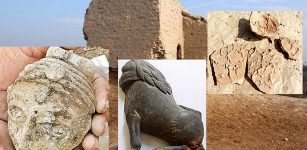 Buddhist ‘Dillu Roy’ Resembles Mohenjo Daro And Harappa And Now Unveils Its Ancient Secrets
Archaeology | Aug 25, 2020
Buddhist ‘Dillu Roy’ Resembles Mohenjo Daro And Harappa And Now Unveils Its Ancient Secrets
Archaeology | Aug 25, 2020 -
 Monks Mound In Ancient Cahokia Was Not What Scientists Previously Thought – New Study
Archaeology | Jul 21, 2022
Monks Mound In Ancient Cahokia Was Not What Scientists Previously Thought – New Study
Archaeology | Jul 21, 2022 -
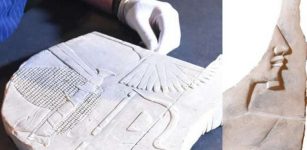 Mysterious Depiction Of Pharaoh Hatshepsut
Archaeology | May 17, 2018
Mysterious Depiction Of Pharaoh Hatshepsut
Archaeology | May 17, 2018 -
 Unusual Viking Secret Hidden Underground In California Reminds Of A Similar Discovery In Colorado
Featured Stories | Sep 12, 2024
Unusual Viking Secret Hidden Underground In California Reminds Of A Similar Discovery In Colorado
Featured Stories | Sep 12, 2024 -
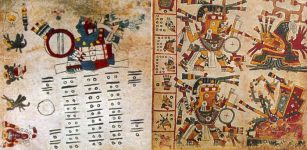 Ancient Codex Cospi: Intriguing Pre-Columbian Ritual Manuscript From Central Mexico
Featured Stories | Aug 10, 2017
Ancient Codex Cospi: Intriguing Pre-Columbian Ritual Manuscript From Central Mexico
Featured Stories | Aug 10, 2017 -
 Did Leonardo Da Vinci Invent Contact Lenses In 1508?
Ancient Technology | Dec 10, 2015
Did Leonardo Da Vinci Invent Contact Lenses In 1508?
Ancient Technology | Dec 10, 2015 -
 Trident: Powerful Religious Symbol Found In Many Ancient Cultures
Ancient Symbols | Dec 4, 2019
Trident: Powerful Religious Symbol Found In Many Ancient Cultures
Ancient Symbols | Dec 4, 2019 -
 Ancient Maya Destroyed Their Environment 2,000 Years Ago – Effects Are Still Visible Today
Civilizations | Sep 9, 2015
Ancient Maya Destroyed Their Environment 2,000 Years Ago – Effects Are Still Visible Today
Civilizations | Sep 9, 2015 -
 What Is The Curse Of The Ninth Symphony?
Ancient History Facts | Aug 3, 2018
What Is The Curse Of The Ninth Symphony?
Ancient History Facts | Aug 3, 2018


